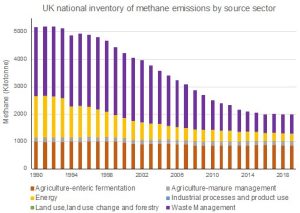
Blog post written by Dr Semra Bakkaloglu
Dr Semra Bakkaloglu is a research associate at the Sustainable Gas Institute (SGI), who works on the Methane and Environment Programme. We asked her to write a short blog post about a recent Royal Society meeting on tackling methane emissions where she was an invited speaker.
Scientists from all around the world gathered at the Royal Society ‘Rising methane: is warming feeding warming’ online meeting on October 4-7, to present and discuss the global methane budget, satellite observations of methane, natural and anthropogenic methane emission sources, and strategies for methane emissions mitigation and removal.
Despite efforts taken in many countries to reduce emissions, methane mole fraction (the amount of methane) is rising globally. It is important to understand what is causing the rise in methane concentrations as the rise makes meeting the goals of the 2015 Paris Agreement more difficult. However, the causes of methane growth and evidence from carbon isotopes (for example, the depletion in Carbon-13 isotope) is largely unknown: sources of methane emissions may be increasing, and sinks (methane being removed from the atmosphere) may be declining, or both processes may be occurring together (Nisbet et al., 2020). A sink occurs when methane is removed from the atmosphere by oxidation in a reaction with hydroxyl radical (OH).

I was excited to be invited to present the results of my PhD study on Day 4 during the industrial session. One of the points I emphasised during my presentation was the significance of methane emissions from biogas plants, as well as how these emissions are often overlooked in inventories. I also highlighted the differences in the isotopic signatures from waste sources, such as there being more depleted in Carbon-13 (13C) for active sites in landfill areas compared to closed sites, and different feedstock release different isotopic signatures. Wastewater treatment also influences the isotopic signature in terms of whether treatment is aerobic (requires oxygen) or anaerobic.
Understanding the evolution of waste generation and treatment processes can lead us to develop new methods to reduce emissions from these sources. The more information we have on the isotopic signature, the easier it is to evaluate specific waste sources on a regional and global scale. With these data, we can better understand the Carbon-13 temporal trends of the global methane record and gain a better understanding of the reasons for the rise in methane. More details can be found in our paper in Waste Management published in August.
My old PhD supervisor, Dr Dave Lowry from Royal Holloway University of London (RHUL), spoke next and demonstrated the changes in the isotopic signature of the UK source mix over time. Biogenic sources, such as wetlands, agricultural and waste sources, are dominant in rural areas, with Carbon-13 isotopic signatures ranging from -65 to -60‰, whereas gas leaks are the dominant methane source in urban areas. Over the last 30 years, the methane source mix has been depleted by 8‰ due to a number of reasons. For example, an increase in methane recovery systems and reductions in the amount of waste disposed at landfill sites, as well as a gradual decline in the proportion of isotopically-enriched southern North Sea Gas in the UK distribution network and a decline in anthracite (hard coal) production and move from deep to open cast mining. Julianne Fernandez, a PhD student in RHUL, assessed methane emissions from London gas network and found that London emits far more methane than Paris. Dr. Lowry and his team’s research will help local governments to prioritise methane mitigation strategies so as to meet the new target of the US-EU pact on the Global Methane Pledge of at least a 30% reduction in methane by 2030.
The next speaker was Prof. Grant Allen of the University of Manchester, who discussed how to quantify methane emissions. He talked about the progress being made in unmanned aerial vehicle (drone) measurements of methane and other greenhouse gases, as well as how drone-based sampling of methane concentrations can be used to calculate emission fluxes from landfills, fracking sites, and dairy herds.
The final speaker was Dr Stefan Schwietzke from the Environmental Defense Fund. Stefan highlighted the inconsistencies and low biases in many emission inventories, and emphasised the importance of measurements in guiding mitigation and tracking progress. His talk focused on the currently understudied offshore oil and gas sector. He concluded by drawing attention to ongoing efforts to improve transparency in the fossil fuel industry’s emissions reporting by incorporating empirical estimates and integrating them with independent datasets (for example, satellite data and field studies).
The industrial methane session informed us of ongoing international efforts to limit the global methane budget. Understanding and quantifying the anthropogenic methane emissions and their isotopic signature are critical to improving our understanding of the methane cycle and its anthropogenic component. This way, we can mitigate climate change and achieve emission reduction strategies outlined in the 2015 UN Paris Agreement on Climate change.
The entire discussion can be viewed on the Royal Society’s YouTube channel.